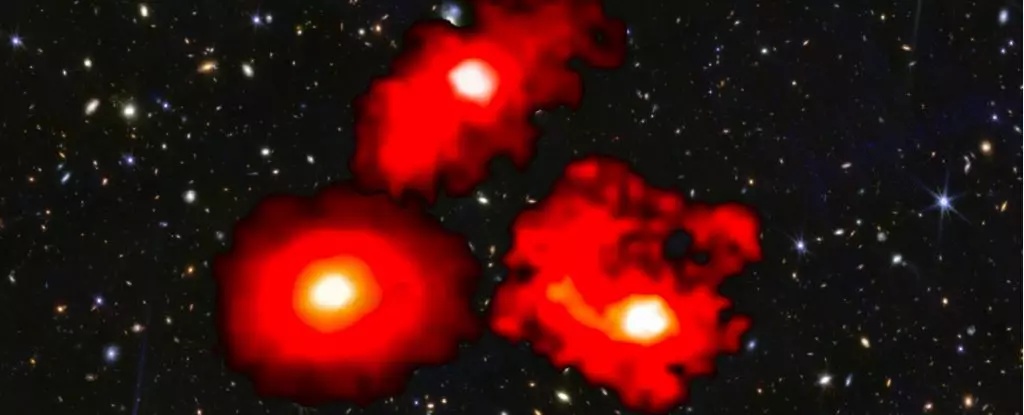In an extraordinary leap for astrophysics, scientists have identified what they term ‘red monsters’—three exceptionally large galaxies, each comparable in size to our Milky Way, dating back to the early Universe. This revelation invokes both excitement and bewilderment, significantly challenging our established understanding of cosmic evolution during the formative years immediately following the Big Bang. Ivo Labbé, an astronomer from Swinburne University of Technology, aptly compares this conundrum to finding an impossibly heavy toddler—an image both startling and illustrative of a broader scientific puzzle. The existence of such massive galaxies in an early cosmic timeline previously thought incompatible with their observed properties introduces a compelling anomaly in the field of cosmology.
Cosmic Dawn, the term used to describe the initial billion years post-Big Bang, remains largely mysterious to astronomers. Current cosmological models provide insights into the universe’s assembly process, primarily involving dark matter clusters collecting baryonic matter which ultimately forms galaxies. However, the timeline, evolution, and structural development of these galaxies in the early Universe is still not well understood. The advent of the James Webb Space Telescope (JWST) has transformed how we gather observational evidence from this epoch, as its infrared capabilities stretch the light from distant celestial objects, enabling in-depth exploration of the universe’s nascent structures.
Initial interpretations suggested a steady and gradual formation process, whereby galaxies would grow incrementally. Yet, in a stunning twist, observations from the JWST are revealing a different narrative, one that suggests galaxies of immense proportions were somehow formed far sooner than theoretical models would predict. This dichotomy between expectation and observation compels the astronomical community to re-evaluate existing paradigms about galaxy formation and maturation.
The JWST symbolizes a significant evolution in astronomical technology, offering unprecedented clarity and depth of view into the cosmos. By probing the far reaches of space, it has illuminated aspects of cosmic history hitherto obscured by light’s extensive journey across time and space. Researchers employed the JWST’s FRESCO program, a collaborative initiative aimed at accurately measuring galaxy distances and masses, and their findings have been as staggering as they are illuminating.
Among the many galaxies examined, three stood out markedly due to their size and mass, dwarfing the existing data models. Surprisingly, these red monsters exhibited star formation rates two to three times higher than those of the most productive galaxies in later epochs. This increased efficiency leads to new questions about the nature of stellar birth and how these galaxies, situated thousands of millions of years in the past, circumvent the conventional constraints typically associated with star formation.
While the mere existence of these vast galaxies does not directly contradict prevailing cosmological models or the theory of dark matter, it does challenge the understanding of star formation processes. Theories suggest that vigorous star formation should cause substantial feedback mechanisms—energetic processes resulting from stellar deaths and black hole activity that would ordinarily impede further star birth. Labbé emphasizes that existing models struggle to reconcile these dynamics, revealing that current astrophysical frameworks may not fully encapsulate the realities of early galactic growth.
As scientists dissect the implications of these findings, it becomes evident that there remains a significant gap in our knowledge. How could early galaxies produce and sustain such high rates of stellar formation without facing the expected constraints imposed by their mass and activity levels? This question not only tests the limits of current theories but encourages innovative thinking within the astrophysical community.
The unveiling of the red monsters encourages scientists to delve deeper into the intricate processes driving cosmic evolution. As the boundaries of our knowledge expand, new models must be developed that can incorporate these remarkable observations. Future research will likely focus on understanding the mechanisms that could allow for rapid star formation in such massive early galaxies, potentially leading to revolutionary advancements in our comprehension of the Universe’s history.
The discovery of these galaxies does not merely prompt a revision in perspectives but also underlines the importance of continuous observation and the development of cutting-edge astronomical technology. As we further explore the cosmos with instruments like JWST, we stand likely to uncover more surprises that will reshape our understanding of galaxy formation and the fundamental workings of the Universe.
The emergence of the red monsters is not just an anomaly; it’s a doorway to a new realm of understanding in cosmology, beckoning scientists to rethink and reconstruct the narrative of our Universe’s early days.


Leave a Reply